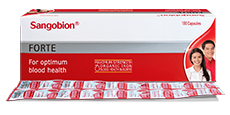
The human body needs a variety of key nutrients - one of which is iron - to function optimally. Iron is one of the 20 minerals found in food.
However, the body does not produce this mineral; it is only able to store the iron derived from food sources and supplements.
IRON'S ROLE
Your body needs iron to make red blood cells to carry oxygen around your body and for proteins in your muscles. They give you the energy you need for your daily activities. Iron is also needed for many other roles including your immune system to help fight infections, and is vital for normal child growth and intellectual development. If you do not have enough, you may lack energy and get sick often. Iron is needed for optimum brain function in adults and children.
SPECTRUM OF IRON DEFICIENCY

Australian Red Cross Lifeblood. Iron deficiency without anaemia. https://transfusion.com.au/anaemia_management/iron_deficiency_without_anaemia.
Modified from Sarah Cusick PhD. Centers for Disease Control and Prevention, 2008.
WHAT IS IRON DEFICIENCY?
Iron deficiency is more common than you think. According to a study, the total cases of anemia increased from 1.42 (1.41 -1.43) billion to 1.74 (1.72 -1.76) billion in 2019.
Iron is found in the body in two forms as functional iron and as storage iron. When people have depleted their stores of iron, they are said to be 'iron deficient'. When you have iron deficiency, you may develop symptoms such as fatigue or impaired concentration, or find you can't exercise to your full capacity.
When the depletion progresses, the hemoglobin concentration in red blood cells falls below the normal range (the 95 percentile for age). At this point, a person is classified as having anemia, Iron deficiency can exist with or without anemia.6
WHO'S AT RISK?

WOMEN OF REPRODUCTIVE AGE

YOUNG CHILDREN AND ADOLESCENTS

ADULTS AND ELDERLY
Iron deficiency can affect anyone, but women, children and elderly are most at risk. Women of reproductive age - menstruation and pregnancy are some of the key factors - are among the most vulnerable groups. Young children and adolescents can also be more vulnerable to it. So can adults with long-term illnesses like diabetes, and kidney and liver diseases.7
REFERENCES:
6 Bersamin, A. et.al. Iron and Iron Deficiency Anemia Nutrition and Health Info Sheet. ANR University of California Publication 8141. ISBN-13:978-1-60107-498-0
7 Iron Disorders Institute: Iron Deficiency Anemia. http://www.irondisorders.org/iron-deficiency-anemia
If symptoms persist, consult your doctor. ASC Reference No. P141P071321SS
Supports Optimum Blood Health
With proper diet and exercise

Multi-vitamins + Minerals


Multivitamins + Iron + Calcium


Iron + Folic acid


Iron + Vitamin B Complex

If symptoms persist, consult your doctor. ASC Reference No.: P170P062921SS

